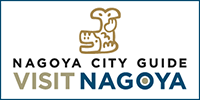
Food and tourism navigation
Introduction to NAGOYA
A city in the center of the Chubu Region
Nagoya is located in the center of Honshu (the main island of Japan) and has a population of 2.24 million. Thanks to the abundant water resources of the Kisogawa, Nagaragawa and Ibigawa rivers, the resulting fertile land, and good transportation links, its people have long enjoyed affluent lives.
Nagoya has a long history and is the birthplace of three notable feudal lords: Oda Nobunaga, Toyotomi Hideyoshi and Tokugawa Ieyasu. Also in Nagoya, traditional industries like ceramics and textiles, and today’s key industries like automobiles, aviation and machine tools have developed. Nagoya continues to play an important role in Japan’s industrial society.
Furthermore, Central Japan International Airport (Centrair) opened in February 2005, and in March 2005, Expo 2005 Aichi Japan was held.
Today, Nagoya is attracting attention and continuing to develop as an international Japanese city.
Nagoya, with a long and important role in Japanese history
Nagoya has a long history dating back 1900 years to when Atsuta Jingu, which has a close relationship with legendary persons appearing in Kojiki (the oldest history book of Japan), was established. Nagoya is especially defined by its history after the establishment of Nagoya Castle. In the 16th century, after a prolonged war-torn era, Tokugawa Ieyasu was victorious at the Battle of Sekigahara in 1600. This event marks the start of the Edo Period which lasted for 300 years.Ieyasu, who became the first shogun (commander-in-chief), built Nagoya Castle and moved the whole town of Kiyosu, the central city of the region until then, to Nagoya. This migration is called Kiyosugoe and occurred in 1614. Then, the first lord of Nagoya Castle, Tokugawa Yoshinao promoted the infrastructure of Nagoya as a castle city, which contributed to the prosperity of the Owari Tokugawa family. In the era of the 7th Lord, Tokugawa Muneharu, culture, including Noh, Kyogen and tea ceremony flourished. Such culture, along with information regarding the development of Nagoya and the prosperity of the Owari Tokugawa family, from craftworks to books, are treasured and exhibited at Tokugawa Art Museum.
Approach to nature and the environment
Verdant parks, including Higashiyama Park which contains a large zoo and a botanical garden, are scattered throughout Nagoya from the northwest to southwest. Fujimae Tidal Flat, a globally important layover for migratory birds located near the Port of Nagoya, was registered in the Ramsar Convention in November 2002. In addition, Nagoya has adopted the philosophy of “Expo 2005 Aichi Japan” held from March to September 2005, and continues environmental preservation activities to become “Eco-Capital Nagoya”.
A leading industrial city of Japan
Nagoya contains a ceramic production area with a history of over 1000 years, a textile production area, and a brewing industry, which includes sake (rice wine). Industrial technologies of Japan accumulated in Nagoya and its environs from the 19th and 20th centuries with the development of manufacturing industries based on traditional manufacturing. Several disused factories are maintained and now used as museums to show the lively history of modern industries. Nagoya draws attention as a manufacturing city.
Art and culture cultivated by history
In the Edo Period, the prosperity of the Owari Tokugawa family and the Tokaido Road brought human and material resources and technologies to Nagoya. The 7th lord, Tokugawa Muneharu administered affairs of state with great originality, and completely changed the previous policies of simplicity, fortitude and belt-tightening. His sensational style galvanized Nagoya. Commerce developed along with the development of the Tokaido Road, rich merchants learned arts like tea ceremony, Noh and Kabuki, and literature like waka (tanka: 31-syllable Japanese poems), and haiku.All of this helped cultivate the unique and magnificent Nagoya culture. This is also why Nagoya became noted as the city of artistic culture along with other big cities like Edo, Kanazawa, and Kyoto. Local industries, including ceramics, tie-dying, and Japanese paper were passed on from one generation to another. Many such industries are still alive and prospering.
Developed tastes combining Western Japan and Eastern Japan food cultures (Specialties of Nagoya)
Akamiso (reddish-brown fermented bean paste) is a food ingredient unique to Nagoya and its environs. Although its appearance is unappetizing to some, it is an ingredient with a unique flavor that can be used in preparing a wide variety of dishes. The representative examples are miso-nikomi-udon (Nagoya style udon served hot in a pot with miso soup) and miso-katsu (fried pork cutlet with rich red miso sauce).People can savor different flavors from those of Tokyo or Osaka and enjoy combinations of ingredients or ways of cooking unique to Nagoya. The unique cuisine of Nagoya is fascinating.
A beautiful city with a cityscape that harmonizes history and modernity
The City of Nagoya held the World Design Expo in 1989 and that experience led Nagoya to emphasize its cityscape as well as its city functions. Nagoya is a safe and convenient city, while practicing innovation in design that beautifies the whole city and allows the citizens to live comfortably. For example, night illumination not only makes the city attractive but reduces crime. In 2002, Oasis 21 was established in Sakae, one of the busiest areas in Nagoya: it combines parks, public facilities such as a bus terminal, and commercial facilities. Preservation of historical townscapes, including those of Arimatsu and Shikemichi, is emphasized.In Nagoya, urban design with a historical cityscape and modern functions is being pursued.






